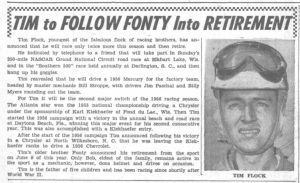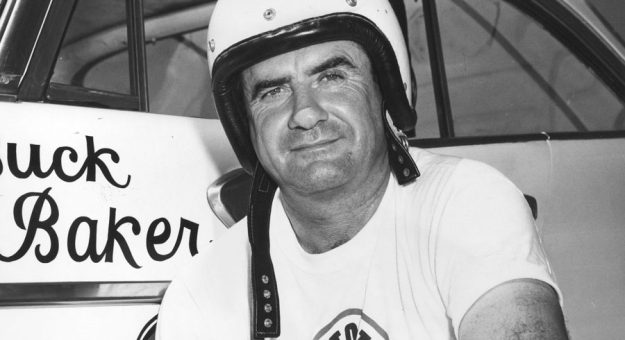Editor’s Note: NASCAR is celebrating its 75th anniversary in 2023. SPEED SPORT was founded in 1934 and was already on its way to becoming America’s Motorsports Authority when NASCAR was formed. As a result, we will bring you Part 9 of a 75-part series on the history of NASCAR as told in the pages of National Speed Sport News and SPEED SPORT Magazine.
Defending NASCAR Grand National champion Tim Flock, 1951 and ’53 champ Herb Thomas, Al “Speedy” Thompson, Fonty Flock, Jack Smith and Buck Baker shared a common bond in 1956: each driver won in a car owned by Mercury Outboard Co. executive Carl Kiekhaefer.
Backed by the defending championship owner of the year, these six drivers won 30 of the 56 Grand National events beginning with Tim Flock’s conquest in the first race of the point season in Hickory, N.C., and capped by Buck Baker’s victory in the season finale.
Baker alone tallied 14 of the victories en route to his first NASCAR championship.
Baker’s drive to the top of the Grand National division began in 1949 when the former Charlotte, N.C., taxi driver entered two strictly stock events. He didn’t make an impact on the circuit until 1953 when four victories and 25 top-10 finishes placed him in the fourth spot in the standings. His progression continued in 1954 with a third-place finish. He was runner-up in 1955.
A pre-Daytona Beach victory in Phoenix, Ariz., combined with a run of seven victories in 11 starts, during a string of 16 straight triumphs for the Kiekhaefer team, propelled Baker to the championship.
Tim Flock & Mercury Outboard Find Success
The Mercury Outboard team got off to a quick start with Flock’s victory at Hickory followed by a 1-2 finish for Fonty and Flock in Chrysler 300Bs at Charlotte the following week. The defending champ earned Kiekhaefer’s fourth trophy of the season in the high-tide-shortened Daytona Beach race before winning for the final time as a member of the team at North Wilkesboro (N.C.) Speedway.
Flock announced his intention to leave the team and he drove 1956 Mercury for the remainder of the season, including his Aug. 12 victory on on the 4.1-mile road course in Elkhart Lake, Wis. The Aug. 8 issue of NSSN reported Flock would retire from racing after the Southern 500 at Darlington (S.C.) Raceway.

Still, Flock returned to compete in the Grand National division on a limited basis through 1961.
Flock’s announcement came two months after his brother, Fonty, decided to leave racing as well. A victor in every major race on the Grand National circuit, the 35-year-old finished in the top five of the standings four times between 1949 and 1953.
Yet, even the retirement comments of this NASCAR veteran pointed to the domination of the Kiekhaefer organization: “I always did say if I ever left Kiekhaefer, I would quit,” stated the former member of the Mercury Outboard team in the June 13 edition of NSSN. “You step into one of his cars and you’re almost a cinch.”
Proof of Fonty’s statement is the fact that, by the beginning of October, the top three drivers in the points race drove cars with the stenciled insignia of the Mercury Outboard Motors Co.
The October 3 issue of NSSN lists Thomas in first after his fifth-place finish on the circular mile Langhorne (Pa.) Speedway, followed by Baker, who fell to second after placing 38th in the same race. Thompson held third in the standings. Unfortunately, Thomas’ strong season came to an abrupt end on the 111th lap of the Oct. 23 feature in Shelby, N.C.
As he made a move for second place, Thomas’ No. 92 scraped the outside fence and flipped across the track where it collided with teammate Jack Smith and five others. Thomas was critically injured, but recovered to race again.
NASCAR Growth Continues, Developments Demand Attention
In a year when Baker’s drive to the top in a Kiekhaefer car dominated NASCAR headlines, other developments demand attention.
The Pepsi-Cola Co. joined the parade of businesses aligning with Bill France’s organization when, in conjunction with NASCAR-sanctioned tracks across the nation, race-attending fans could register to win Thunderbird Juniors or Vespa Motor Scooters, which were awarded in June.
NASCAR grew again after a merger with the Society for Autosport Fellowship and Education, a Midwestern circuit which featured convertibles. Charlie Scott became the first African-American to compete in a NASCAR event when he completed the Daytona Beach race in 19th position.
Also, the point fund Baker garnered, in the Grand National division, was divided among the top 20 drivers this season, not just the top 10.
Other season champs from NASCAR’s record nine divisions were Bob Welborn in the new convertible division, despite Curtis Turner’s 22 victories, and Fred Meeker in the midget class.
Jim Reed took home top honors in the short track division for the fourth time and Johnny Mann was the Ford midget champion. Fred Pfisterer grabbed the sports car 500cc season laurels and Jake Jacobs was the sports car 1500cc king.
Ralph Earnhardt swept the sportsman division and Red Farmer was the modified champion in 1956.
